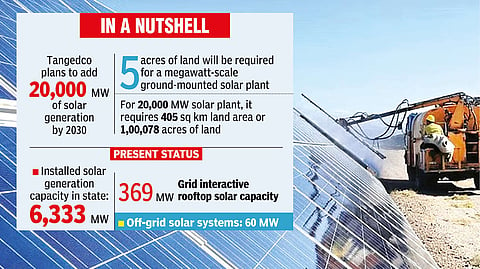

CHENNAI: A whopping 405 square kilometres of land will be required to achieve the Tamil Nadu government’s ambitious target of generating 20,000 Megawatt solar energy by 2030, reveals an analysis by Auroville Consulting.
If the state wants to meet the 20,000 MW solar energy target primarily through ground-mounted solar plants, the land requirement for achieving it would be 405 sq km of land or one lakh acres of land, said the report titled, “The Solar Energy - Land Nexus.”
The solar capacity addition along with other renewable sources like wind and hydro will help the state meet its renewable purchase obligation of 43 per cent of the state’s total energy demand for 2029.
“Considering the projected annual electrical energy demand of 4,89,395 MU by 2050, the need to decarbonise the state’s power sector and the fact that solar is among the most cost-efficient energy sources today, the potential land impact of solar is substantial. Meeting 50% of the projected electricity demand for 2050 would require 133 GW of solar capacity and 2,691 sq km of land resources, which equals the total geographical area of Chengalpattu district or 2.07% of the state’s geographical area,” the report authored by Martin Scherfler, co-founder, Auroville Consulting said.
Pointing to the competing and often conflicting demands for land for economic, ecological, and social needs in the development sector, the report said that it would be critical to limit the conversion of agricultural lands for solar energy development.
“Land-neutral and low land-impact solar energy developments need to be prioritised. The concept of land-neutral solar projects refers to the integration of solar projects into existing buildings and infrastructure assets. Floating solar energy on water bodies can be considered a land-neutral option as well. Low land-impact solar energy also includes agrovoltaic projects that facilitate the co-location of agriculture and solar energy generation or wind-solar hybrids. Developing energy on lands degraded by human activities is another option to reduce cumulative impacts and minimize land use conflicts,” it said.
A senior Tangedco official said that the solar generation planned by the department would be distributed to generation stations to avoid transmission loss.
“After we wrote to district collectors to identify lands for setting up the solar plants, the district administrations have identified over 6,300 acres of land in several districts including Salem, Thiruvarur, Karur and Kancheepuram. The first solar project would come up in Thiruvarur district,” the official said, adding that the solar plants would be distributed across the state.
Visit news.dtnext.in to explore our interactive epaper!
Download the DT Next app for more exciting features!
Click here for iOS
Click here for Android